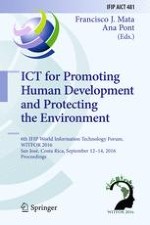2016 | Book
ICT for Promoting Human Development and Protecting the Environment
6th IFIP World Information Technology Forum, WITFOR 2016, San José, Costa Rica, September 12-14, 2016, Proceedings
Editors: Francisco J. Mata, Ana Pont
Publisher: Springer International Publishing
Book Series : IFIP Advances in Information and Communication Technology
